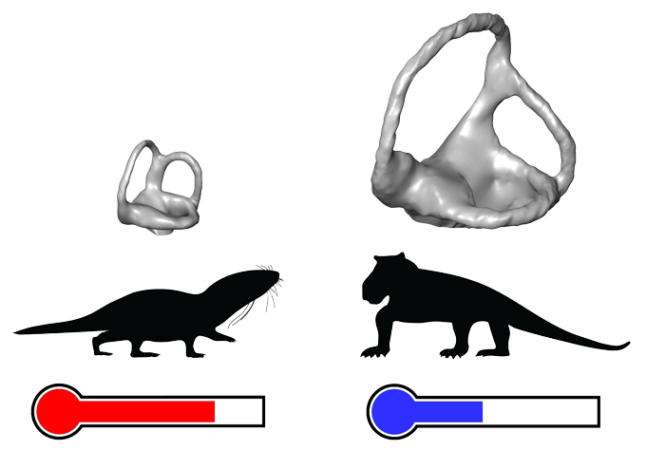Hot or not? Peeking inside an animal’s ear — even a fossilized one — may tell you whether it was warm- or cold-blooded. Using a novel method that analyzes the size and shape of the inner ear canals, researchers suggest that mammal ancestors abruptly became warm-blooded about 233 million years ago, the team reports in Nature July 20.
Warm-bloodedness, or endothermy, isn’t unique to mammals — birds, the only living dinosaurs, are warm-blooded, too. But endothermy is one of mammals’ key features, allowing the animals to regulate their internal body temperatures by controlling their metabolic rates. This feature allowed mammals to occupy environmental niches from pole to equator, and to weather the instability of ancient climates (SN: 6/7/22).

Sign Up For the Latest from Science News
Headlines and summaries of the latest Science News articles, delivered to your inbox
Client key* E-mail Address* Go
Thank you for signing up!
There was a problem signing you up.
When endothermy evolved, however, has been a mystery. Based on fossil analyses of growth rates and oxygen isotopes in bones, researchers have proposed dates for its emergence as far back as 300 million years ago.
The inner ear structures of mammals and their ancestors hold the key to solving that mystery, says Ricardo Araújo, a vertebrate paleontologist at the University of Lisbon. In all vertebrates, the labyrinth of semicircular canals in the inner ear contains a fluid that responds to head movements, brushing against tiny hair cells in the ear and helping to maintain a sense of balance. That fluid can become thicker or thinner depending on body temperature.
“Mammals have very unique inner ears,” Araújo says. Compared with cold-blooded vertebrates of similar size, the dimensions of mammals’ semicircular canals — such as thickness, length and radius of curvature — is particularly small, he says. “The ducts are very thin and tend to be very circular compared with other animals.” By contrast, fish have the largest for their body size.
What if, Araújo and his colleagues hypothesized, the size and shape of the ear canals are related to the animal’s body temperature? In warm-blooded animals, the fluid becomes less viscous, and the canals may have shrunk to compensate. If so, it might be possible to trace how the shape of fossilized inner ear canals changed over time to discover when warm-bloodedness emerged in the mammal lineage.
To test that hypothesis, the researchers created a tool they call the “thermo-motility index” to link warm-bloodedness to those inner ear dimensions in 341 different vertebrates. Accounting for size differences, the value of this index turned out to closely track an animal’s body temperature, from fish to reptiles to mammals. Reptiles had low index values; mammals were high.
The team then applied this index to the fossilized ear canals of 56 extinct mammal ancestor species. To their surprise, the data showed a sharp change in inner ear morphology around 233 million years ago. That would correspond to an increase in body temperature of between 5 and 9 degrees Celsius — suggesting that endothermy evolved abruptly around that time, the team concludes.
Heating up
The inner ears of warm-blooded mammal ancestors called mammaliamorphs (illustrated, left) that lived in the Late Triassic Period had smaller, more tightly curved inner ear canals compared with earlier cold-blooded synapsids (right), which lived during the Permian Period. Analyses of the ear canal dimensions of mammal ancestors suggests warm-bloodedness emerged abruptly in the mammal lineage around 233 million years ago.
 Romain David and Ricardo Araújo
Romain David and Ricardo Araújo
“The fact that it is a sharp break in the data [suggests] the transition happened rapidly, within about a million years,” says coauthor Kenneth Angielczyk, a paleontologist at the Field Museum in Chicago.
It’s a clever study, says Stephen Brusatte, a paleontologist at the University of Edinburgh who was not involved in the work. “I’ve been using [computed tomography] data to study the shapes of inner ears for years, to try to infer how extinct species moved and how they could hear, and it never occurred to me that inner ear shape is related to metabolism and could be used to predict body temperatures of fossil species.”
However, Brusatte notes that there is a limit to what scientists can glean from fossilized ear canals alone, as they don’t reveal what soft tissues may have been present, such as the hair cells, or the actual viscosity of the ear fluid. “Shape alone may not always be sufficient to predict something as complex as body temperature or metabolic style.”
The timing of the purported shift, about 233 million years ago, corresponds to a geologically brief interlude of highly unstable climate known as the Carnian Pluvial Episode (SN: 9/30/21). “It was a time when global temperatures were changing a lot, and it was also a very wet, humid time,” Angielczyk says. “One of the benefits of endothermy is that it stabilizes the internal body environment, lets you operate independent of environmental conditions.”
The finding highlights how “the whole Triassic was a bit insane,” Araújo says. The start of the Triassic was epically hot, coming on the heels of the “Great Dying” mass extinction at the end of the Permian Period (SN: 12/6/18). Vertebrate species had just begun to recover from that event when they were hit with the Carnian Pluvial Episode. Yet the Triassic also saw the dawn of both mammals and dinosaurs — both of which managed to survive.
It was “a crucial time period in the history of life,” Araújo says. All of that instability may have armed both groups with the evolutionary tools they needed to weather yet another mass extinction at the end of the Triassic 201 million years ago (SN: 7/1/22).

